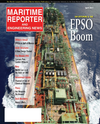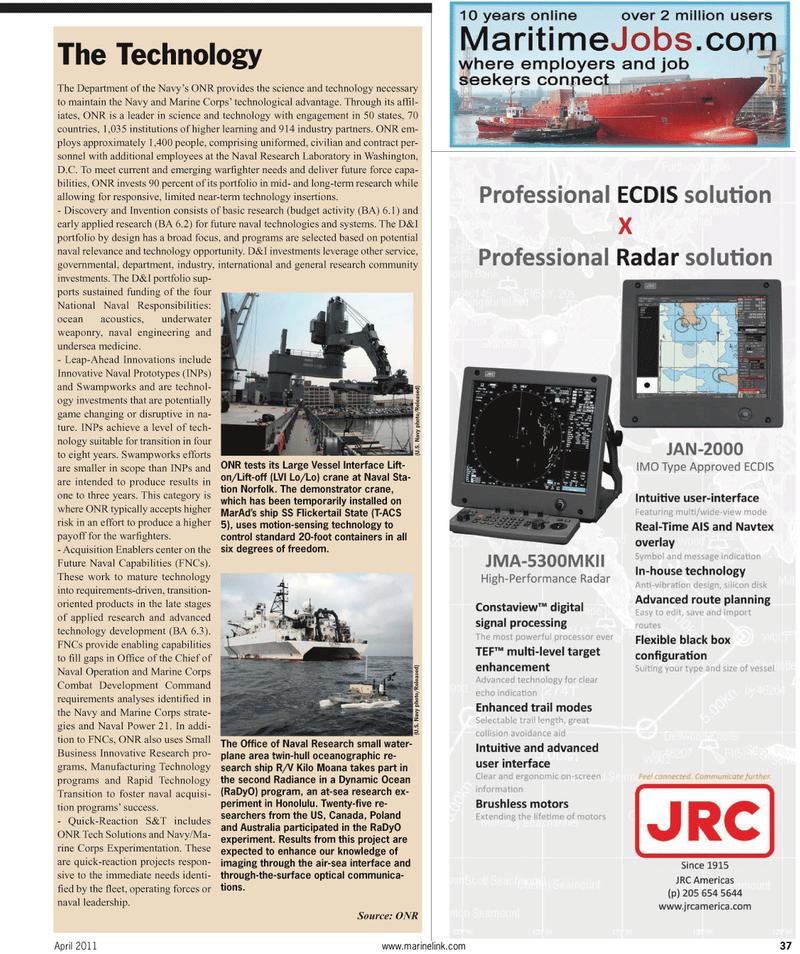
Page 37: of Maritime Reporter Magazine (April 2011)
Offshore Annual
Read this page in Pdf, Flash or Html5 edition of April 2011 Maritime Reporter Magazine
April 2011 www.marinelink.com 37
The Technology
The Department of the Navy’s ONR provides the science and technology necessary to maintain the Navy and Marine Corps’ technological advantage. Through its affil- iates, ONR is a leader in science and technology with engagement in 50 states, 70 countries, 1,035 institutions of higher learning and 914 industry partners. ONR em- ploys approximately 1,400 people, comprising uniformed, civilian and contract per- sonnel with additional employees at the Naval Research Laboratory in Washington,
D.C. To meet current and emerging warfighter needs and deliver future force capa- bilities, ONR invests 90 percent of its portfolio in mid- and long-term research while allowing for responsive, limited near-term technology insertions. - Discovery and Invention consists of basic research (budget activity (BA) 6.1) and early applied research (BA 6.2) for future naval technologies and systems. The D&I portfolio by design has a broad focus, and programs are selected based on potential naval relevance and technology opportunity. D&I investments leverage other service, governmental, department, industry, international and general research community investments. The D&I portfolio sup- ports sustained funding of the four
National Naval Responsibilities: ocean acoustics, underwater weaponry, naval engineering and undersea medicine. - Leap-Ahead Innovations include
Innovative Naval Prototypes (INPs) and Swampworks and are technol- ogy investments that are potentially game changing or disruptive in na- ture. INPs achieve a level of tech- nology suitable for transition in four to eight years. Swampworks efforts are smaller in scope than INPs and are intended to produce results in one to three years. This category is where ONR typically accepts higher risk in an effort to produce a higher payoff for the warfighters. - Acquisition Enablers center on the
Future Naval Capabilities (FNCs).
These work to mature technology into requirements-driven, transition- oriented products in the late stages of applied research and advanced technology development (BA 6.3).
FNCs provide enabling capabilities to fill gaps in Office of the Chief of
Naval Operation and Marine Corps
Combat Development Command requirements analyses identified in the Navy and Marine Corps strate- gies and Naval Power 21. In addi- tion to FNCs, ONR also uses Small
Business Innovative Research pro- grams, Manufacturing Technology programs and Rapid Technology
Transition to foster naval acquisi- tion programs’ success. - Quick-Reaction S&T includes
ONR Tech Solutions and Navy/Ma- rine Corps Experimentation. These are quick-reaction projects respon- sive to the immediate needs identi- fied by the fleet, operating forces or naval leadership.
Source: ONR
ONR tests its Large Vessel Interface Lift- on/Lift-off (LVI Lo/Lo) crane at Naval Sta- tion Norfolk. The demonstrator crane, which has been temporarily installed on
MarAd’s ship SS Flickertail State (T-ACS 5), uses motion-sensing technology to control standard 20-foot containers in all six degrees of freedom. (U.S. Navy photo/Released)
The Office of Naval Research small water- plane area twin-hull oceanographic re- search ship R/V Kilo Moana takes part in the second Radiance in a Dynamic Ocean (RaDyO) program, an at-sea research ex- periment in Honolulu. Twenty-five re- searchers from the US, Canada, Poland and Australia participated in the RaDyO experiment. Results from this project are expected to enhance our knowledge of imaging through the air-sea interface and through-the-surface optical communica- tions. (U.S. Navy photo/Released)

 36
36

 38
38
